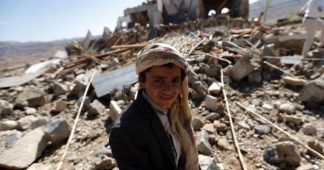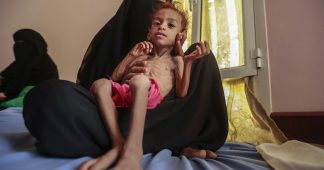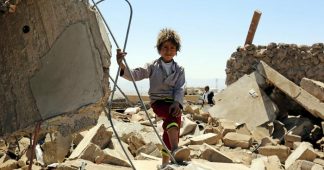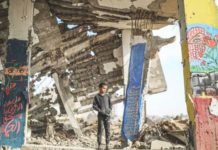December 6, 2018
In Yemen, a place where things couldn’t get worse, things have gotten worse.
85,000 children under the age of five may have died during the war in Yemen, according to the international charitable group Save the Children. This figure was arrived at using data gathered by the United Nations International Children’s Emergency Fund (UNICEF). Save the Children’s November 20 press release states that the children died from “extreme hunger and disease.” Saudi Arabia’s naval blockade of Yemen’s port of Hodeidah is a huge factor in Yemen’s catastrophic food shortage.
Haven’t we already read this story? It has been only a month since the New York Times ran a series of photos of Yemen’s dead and dying. The lead photo is of a 7-year-old Yemeni girl, Amal Hussain, in a state of advanced starvation. Amal has died since the photo appeared.
The images of dead, starving, and mutilated Yemenis are so horrific that the Times took the unprecedented step of explaining why it was running the photos. The reason: because the world needs to see what the Kingdom of Saudi Arabia and the United Arab Emirates, assisted by the US, are doing to Yemen.
The war has turned Yemen, already the Arab world’s poorest country, into the “world’s worst humanitarian crisis,” according to UN Secretary General António Guterres. The UN estimates that 14 million Yemenis face starvation. This should be a source of shame and outrage to Americans. It is US assistance, which makes the aggression of the Saudis and Emiratis possible. The US supports the Saudi-led coalition with arms, intelligence, target-spotting, and (until recently) midair refueling of Saudi warplanes. (According to Forbes, “two-thirds of the 365 combat-capable aircraft in the Saudi inventory are of U.S. origin.”)
Revolt in Congress
On November 9, the US and the Saudis announced that the US was ending midair refueling of Saudi warplanes. Great news, right? Maybe not. Experts say this decision probably won’t mean fewer Saudi air strikes on Yemen. In any event, the US was refueling only about 20% of Saudi warplanes, and the Saudis have announced that they can refuel their planes themselves.
The decision to end in-flight refueling of coalition aircraft may have been made to forestall more radical action by Congress where the war has become increasingly unpopular among members of both parties. What kind of action? There have been several attempts to invoke the 1973 War Powers Resolution. Although honored mostly in the breach, the Constitution gives Congress alone the power to take the US into war. Invoking the War Powers Resolution would (in theory) force the Administration to end its assistance to the Saudis unless it obtains express authorization from Congress.
In February, a trio of senators, Bernie Sanders (I-Vt.), Mike Lee (R-Ut.) and Chris Murphy (D-Conn.)—had introduced a version of the War Powers Resolution: Senate Joint Resolution 54. On November 28, the Senate voted, 63-37, to discharge S.J. Res. 54 from the Senate Foreign Relations Committee to be considered by the full Senate. A final vote on the resolution is expected this week.
Ending US involvement in Yemen via the War Powers Resolution is a long shot. If the War Powers Resolution is approved by the Senate, and then the House, expect it to be vetoed by President Trump. A presidential veto can be overridden by a two-thirds vote in both chambers, but mustering that many votes may be impossible. And it may not even matter. After his veto was overridden, President Nixon simply ignored the War Powers Resolution. Trump would do the same.
Rumors of Peace
What about peace talks? Will the war be ended around a conference table? Numerous attempts to negotiate a cease-fire in Yemen have all failed. Elana DeLozier of the Washington Institute for Near East Policy notes “June 2015 talks in Geneva, September 2015 talks in Muscat [Oman], and December 2015 talks in Biel, Switzerland.” Talks in 2016 dragged on for 108 days with no resolution. Peace talks scheduled for September this year in Geneva fell through when the Houthis, the rebels the Saudis are fighting, failed to show. Most recently, on October 30, Secretary of Defense James Mattis called for a cease-fire within the next thirty days. That didn’t happen, and talks are slated to begin on Wednesday. The only participants in the talks with be the Yemeni government and the Houthi rebels. Not Saudi Arabia or the UAE. Not the US or Iran. UN Envoy Martin Griffiths is in Yemen laying the talks’ groundwork. Griffiths was in Hodeidah recently attempting to convince the Houthi rebels to cede control of the port to the UN. UN control of the port will, hopefully, convince the Saudis to lift their blockade of Hodeidah and allow desperately needed food aid into Yemen.
We should not be too hopeful about these latest talks. I say this based on how the Saudis’ reacted to a draft UN Security Council cease-fire resolution prepared by the UK. In addition to establishing a cease-fire, the resolution would allow food and other humanitarian aid to reach millions of desperate Yemenis. The cease-fire, however, extends only to Hodeidah. That’s a disappointment to human rights groups who have called the draft “watered-down.” But it’s not watered-down enough to please Saudi crown prince Mohammed bin Salman, the prime architect of the Saudi war on Yemen. According to two CNNsources, the crown prince “threw a fit” when he was shown an early draft of the resolution in November. It’s difficult to see how the upcoming peace talks can be both a) meaningful; and b) acceptable to the prince. For now, a UN resolution is off the table. On November 27, CNN reported that the US had “slammed the brakes” on a UN resolution. The US “can’t support a resolution at the moment,” said a CNN source.
The Upside to Genocide
On the bright side, the war in Yemen allows a handful of already obscenely wealthy US defense contractors to amass gargantuan profits. (The bomb which killed 40 Yemeni children on a school bus in August was manufactured by US firm Lockheed Martin.) Focus on that, and ignore the official reasons for US involvement given by Secretary of State Mike Pompeo and Secretary of Defense James Mattis. Pompeo and Mattis gave a rare classified briefing to the full Senate on November 28, in an attempt to persuade the senators to vote down S.J. Resolution 54. The secretaries of State and Defense told the senators that US withdrawal would not end the war; that the US was in Yemen to protect American interests; fight terrorists;[1]and counter an aggressive and expansionist Iran.
The real reason for the 2015 US entry into the war was because President Barack Obama wanted to throw a bone to the Gulf States which had opposed his Iran nuclear deal. The US remains in the war because it wants to keep selling arms to the Saudis. On October 2, the Saudis murdered dissident journalist Jamal Khashoggi in the Saudi consulate in Istanbul. According to the CIA, Khashoggi’s murder was at the direct order of crown prince Mohammed bin Salman. Khashoggi’s murder has ramped up calls for the US to break its ties with Riyadh. Trump, however, says that the US must maintain its ties with the Kingdom in order to preserve American jobs. What Trump really means is that the US must maintain ties with the Saudis in order to protect the profits of American arms manufacturers.[2]
With or without a cease-fire, the US needs to get out of Yemen. To prevent one more child from dying, the war must end now. Call the U.S. Capitol Switchboard at (202) 224-3121 and ask to be connected to your senators. Demand that they vote to approve the War Powers Resolution, S.J. Res. 54, and end US military activity in Yemen.
December 3, 2018
Notes
[1] The fighting terrorists rationale makes no sense inasmuch as S.J. Res. 54 carves out an exception for US operations against Al-Qaeda and ISIS. Whatever happens this week, US military operations in Yemen against Al-Qaeda and ISIS will continue, including the lethal drone strikes, which the US has conducted intermittently in Yemen since 2002.
[2] President Trump is not the only one looking out for US arms dealers. On September 12, Secretary Pompeo falsely certified that the Saudis and the UAE were “undertaking demonstrable actions to reduce the risk of harm to civilians and civilian infrastructure” in Yemen. Hogwash. The UN Office of the High Commissioner for Human Rights reported at the end of August that “There is little evidence of any attempt by parties to the conflict to minimize civilian casualties.” Had Pompeo told the truth, the US would have been required under the National Defense Authorization Act for 2019 to terminate military assistance to the Saudis and the UAE. But that would have jeopardized lucrative arms deals the US has with Saudi Arabia. Pompeo had been warned as much by a high-level State Department official with ties to defense contractor Raytheon, the Wall Street Journalrevealed in an exclusive story.
Plus, Al-Jazeera has reported that “at least five” of the Republican senators who voted against S.J. Res. 54 on November 28 have received campaign funds from “pro-Saudi lobbying groups.”
Published at https://www.counterpunch.org/2018/12/06/yemen-85000-dead-kids/










